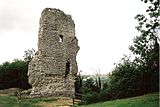| Rape of Bramber | |
|---|---|
 Remains of Bramber Castle, the original administrative centre of the Rape | |
 The Rape of Bramber shown within Sussex | |
| Area | |
| • 1831 | 116,650 acres (182.27 sq mi; 472.1 km2) |
| Population | |
| • 1801 | 19,203 |
| • 1811 | 22,777 |
| • 1831 | 30,113 |
| Density | |
| • 1831 | 0.26 inhabitants per acre (170/sq mi; 64/km2) |
| History | |
| • Created | 11th century |
| • Succeeded by | Sussex (western division) |
| Status | Rape (county subdivision) |
| • HQ | Bramber |
| Subdivisions | |
| • Type | Hundreds |
| • Units | Brightford, Burbeach, West Grinstead, Poling, Singlecross, Steyning, Tarring, Tipnoak, East Easwrith (half hundred), Fishersgate (half hundred), Wyndham (half hundred) |
The Rape of Bramber (also known as Bramber Rape) is one of the rapes, the traditional sub-divisions unique to the historic county of Sussex in England. It is the smallest Sussex rape by area. Bramber is a former barony whose original seat was the castle of Bramber and its village, overlooking the river Adur.